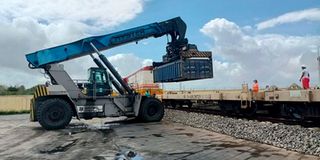Idle clinker capacity is a great loss for the country

Clinker is offloaded at Bamburi Cement factory.
Kenya is a net importer. On paper, we talk of building Kenya. But our trade statistics betray this. We spend more time thinking of what the next plane should bring in for us. This is the case for clinker, a key component in cement production.
However, while the country has sufficient installed capacity to produce this commodity, the economy continues to burn at least Sh8 billion to import clinker. Cement manufactures are paying 10 per cent import duty to bring in nearly two tonnes of clinker annually while National Cement and Mombasa Cement plants remain underutilised.
Several firms plan to expand their clinker capacities by 2023, sending production capacity to 10.7 million tonnes. That would add to the idle capacity. The proposal to hike import duty to 25 per cent, as well as the mentality that imports are always better than local produce, should be reconsidered.
The government has often used protective policies in growing local manufacturing; applying this on clinker should not be made to look like a black swan event. For an economy that wants to increase the share of manufacturing in the GDP, create jobs and build strong dollar reserves, it is ridiculous to keep importing what we can comfortably produce.
Mombasa port
Despite the country having an oversupply of clinker, the product continues to be leading conventional cargo handled at the Mombasa port, costing the country $100 million in foreign exchange annually.
A study commissioned by the Kenya Association of Manufactures (KAM) showed the average cost of imported clinker was $100 (Sh11,039) per tonne when landed in Nairobi. It showed that the factory price for locally produced clinker at between $47 (Sh5,188) and $85 (Sh9,383) per tonne, translating to a saving for cement firms opting for local clinker.
On the price front, there is no debate that there are savings for firms that opt for local clinker. To import raw materials means exporting jobs and losing foreign exchange yet the shilling is under pressure.
Kenyans need more of the local currency to buy dollars, pushing up demand for the greenback to import the Sh1.1 trillion worth of goods over the past seven months. This has put the currency under pressure since June, when it stood at Sh107.8 to the dollar due to reduced dollar inflow from key export sectors like agriculture and tourism.
Last week, the shilling hit a nine-month low against the dollar (Sh110.2) on higher import bill, dearer oil and a stronger greenback.
Clinker production
There is also an agreement that there is excess installed capacity for local clinker production. The sector needs to dissect other matters, such as price stability, quality and reliability of supply and move to empower local manufactures since this promises more jobs and less pressure on foreign currency.
The pricing model should not be pegged on that of imported clinker so that it removes fears that local prices will rise in line with increased import duty.
Kenya National Bureau of Standards should also work with local clinker producers to come up with uniform quality specifications for cement.
With no restrictions for expanding existing plants or setting up new ones, local clinker would make Kenya import-free, hence a win-win for everyone.
Mr Njoroge is a mechanical engineer. [email protected].





